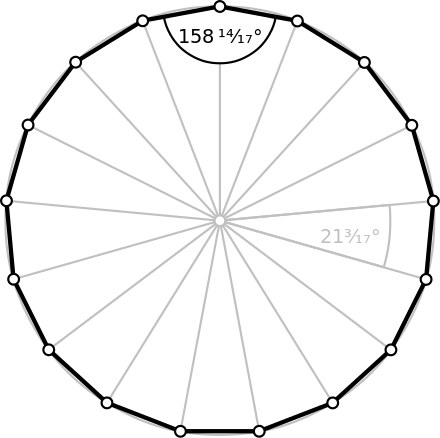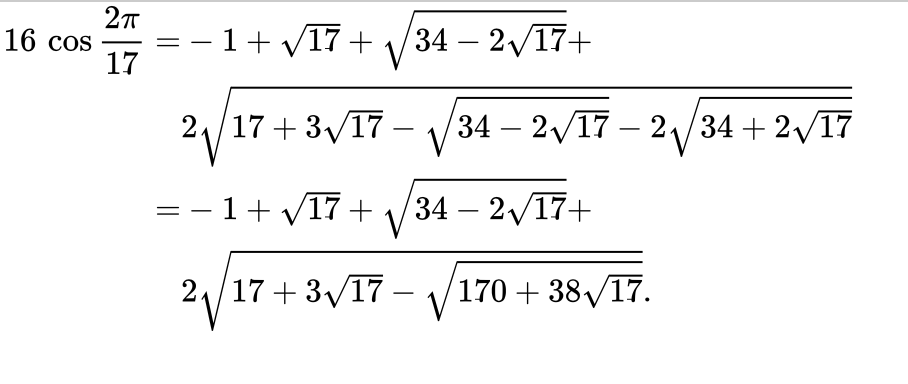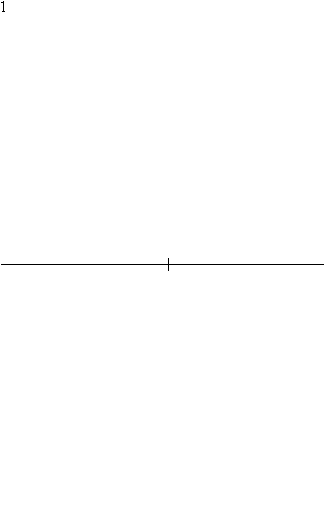
Heptadecagon
Today, I feel like talking about heptadecagons… because pourquoi pas?
A heptadecagon is a polygon with 17 equal sides and angles and 119 diagonals. The sum of its interior angles is 15$\pi$ (2700°) and each interior angle equals 15π/17 (158.82°). But how can one construct such a polygon?
In 1796, a 19 years old Gauss showed how to construct a heptadecagon using only a compass and an unmarked straightedge. The teenage’s proof relies on the property of irreducible polynomial equations and Fermat primes, those of the form $2^{2^n}+1$.
If it is only about proving constructibility, the solution is clear. Taking $360°=17φ$, if $\cos φ$ can be expressed as a square root then the construction is possible as $\cos φ$ represents the $x$ coordinate of a point on the circumference of a unit circle. There is a computational process to prove that:

Given the fact that $S_n=\cos φ + \cos 2φ + \dots + \cos nφ$ implies that $2S_n \sin φ/2 = sin((2n+1)φ/2-sin(φ/2)$ (1) (a simple proof uses trigonometric identities), and setting: $cosφ+cos4φ =a, cos2φ+cos8φ =b, cos3φ+cos5φ =c, cos6φ+cos7φ =d$, and $a+b=e$ and $c+d=f$ you can find that $e+f = \frac{-1}{2}$ ($S_8=\frac{-1}{2}$ by applying (1)) and that $e.f=-1$ by straightforward trigonometric calculation. This means that $e$ and $f$ are solutions to the quadratic equation $x^2+x/2–1$ according to Vieta’s formulas. Thus $e=\frac{-1}{4}+\sqrt{\frac{17}{16}}$ and $f=\frac{-1}{4}-\sqrt{\frac{17}{16}}$. Now, the equation $x^2−ex - \frac{1}{4} = 0$ has roots $a$ and $b$ that yield to $a$ and $b$ expressions, and we find $c$ and $d$ the exact same way. Finally, $\cos φ$ and $cos4φ$ are roots to $x^2− ax + c/2$ because $cos φ · cos 4φ = c/2$. Expressing all those roots yields the expression of $cos(2\pi /17)$ in terms of square roots of 17.
All this calculation is just a confirmation. Gauss uses cyclotomic eqations theory to prove the construction works the way it does. Consider the equation $x^17 -1=0$ and $ζ$ as a 17th primitive root, we have $ζ+…+ζ^{16}+1=0$. Let’s now take a generator of $\mathbb{Z}_{17}^*$, say 3. Then the roots can be expressed as powers of $ζ^3$. Define $x_1=ζ^{3^0}+ζ^{3^2}+\dots+ζ^{3^{14}}$ and $x_2=ζ^{3^1}+ζ^{3^3}+\dots+ζ^{3^{15}}$, then $x_1+x_2=-1$ and $x_1 x_2=-4$. This defines a quadratic for which $x_1$ and $x_2$ are roots. Similarly, define $y_1=ζ^{3^0}+ζ^{3^4}+ζ^{3^8}+ζ^{3^{12}}$ and $y_2=ζ^{3^2}+ζ^{3^6}+ζ^{3^{10}}+ζ^{3^{14}}$ then $y_1+y_2=x_1$ and $y_1 y_2=-1$ defines another quadratic and so on with $y_3=ζ^3 +ζ^5+ζ^{14}+ζ^{12}, y_4=ζ^{10}+ζ^{11}+ζ^7+ζ^6, z_1=ζ+ζ^{16}$ and $z_2=ζ^{13}+ζ^4$.
